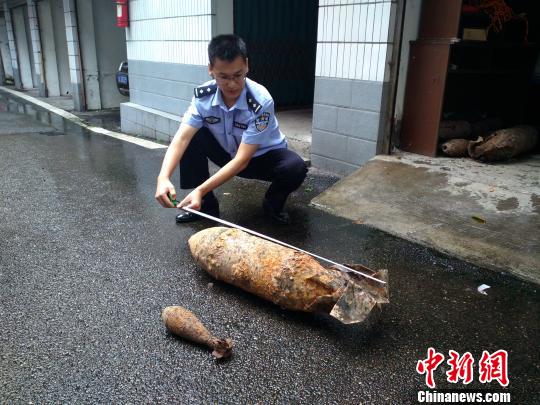Wartime Japanese aerial bomb found in Chongqing
- By Li Jingrong
 0 Comment(s)
0 Comment(s) Print
Print E-mail China.org.cn, August 28, 2015
E-mail China.org.cn, August 28, 2015
According to Chinanews.com, police announced on Thursday that a huge aerial explosive used by a wartime Japanese bomber had been found at a construction site in southwest China's Chongqing Municipality.
 |
|
Police announced on Thursday that a huge aerial explosive used by a wartime Japanese bomber had been found at a construction site in southwest China's Chongqing. |
The bomb was discovered by workers laying the foundation for a building at the ruins of an abandoned steel plant in the Shapingba District of Chongqing on Wednesday afternoon. A worker, surnamed Yang, unearthed it from an eight-meter-deep pit before local police officers were called to the scene.
At first, workers said they didn't know how to handle the situation. Eventually, a nearby resident reminded them to report it to the police.
The "huge iron lump," as described by the police, was about 90 centimeters long and more than 50 kilograms in weight. "With such a volume and weight, it couldn't be a shell. It's more likely an aerial bomb," the police said, adding that the explosive was rusty but nearly intact with only its tail slightly damaged.
The Tegang Steel Plant was a military factory during the Chinese People's War of Resistance Against Japanese Aggressions between 1937 and 1945, so the newly discovered explosive was probably left by the Japanese military which bombed Chongqing, a major target of the Japanese military during the war, said police.
Further investigations revealed that the bomb's fuse and explosive cabin were still in good shape. Although the explosive is awaiting further research, it's already been determined to be extremely dangerous. Conservative estimates have rated its destructive power to have a 30-meter radius.
A specialist in explosive ordnance disposal explained that aerial explosives were specially designed and that there's little probability for an aerial bomb to have broken down. This aerial explosive remains intact probably because it landed on a comparatively soft area, creating a buffer effect which caused it to drill directly into a deep underground location, failing to detonate.
Presently, the aerial bomb is being kept safe by the police and is expected be destroyed along with other remnants of war.





